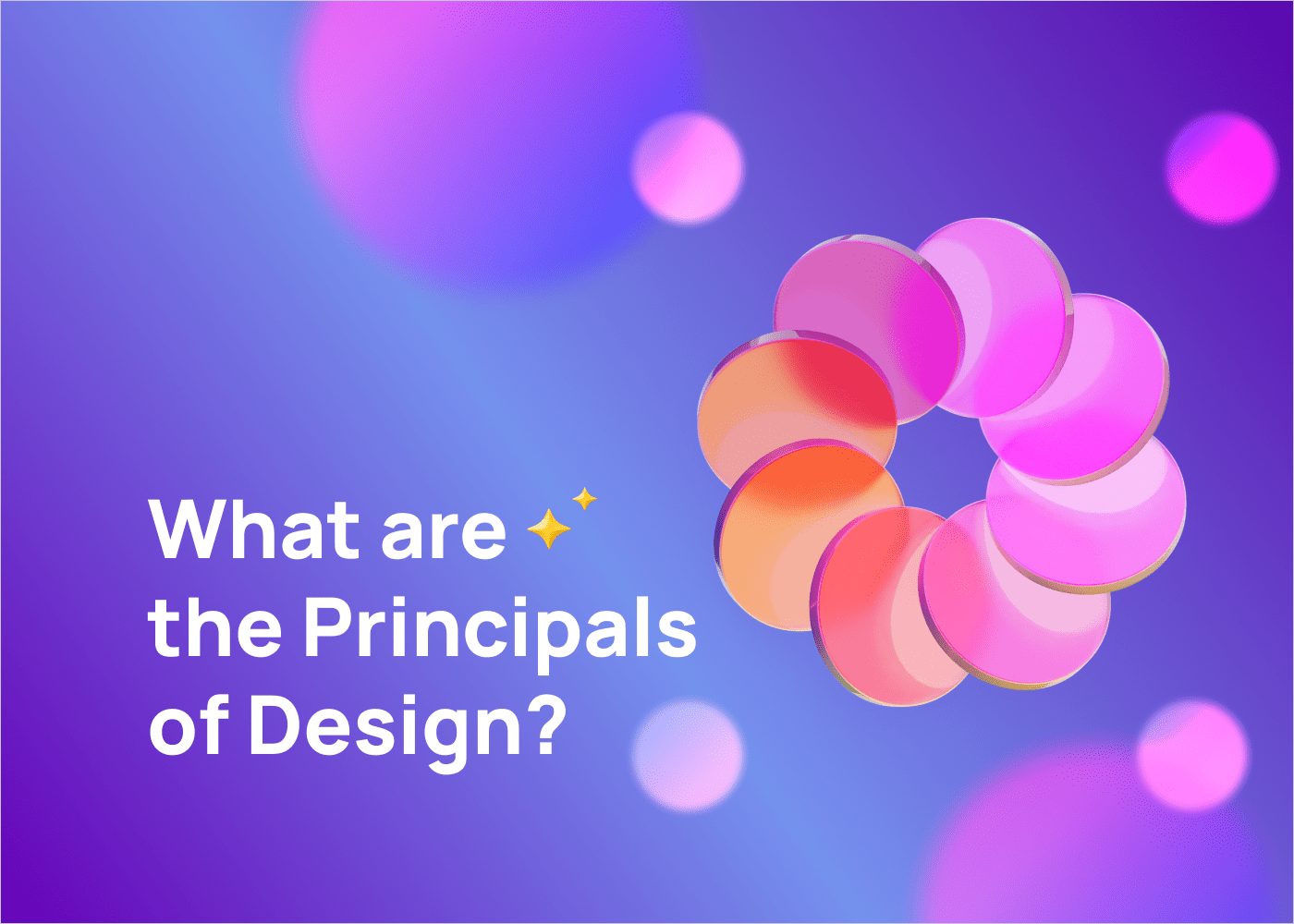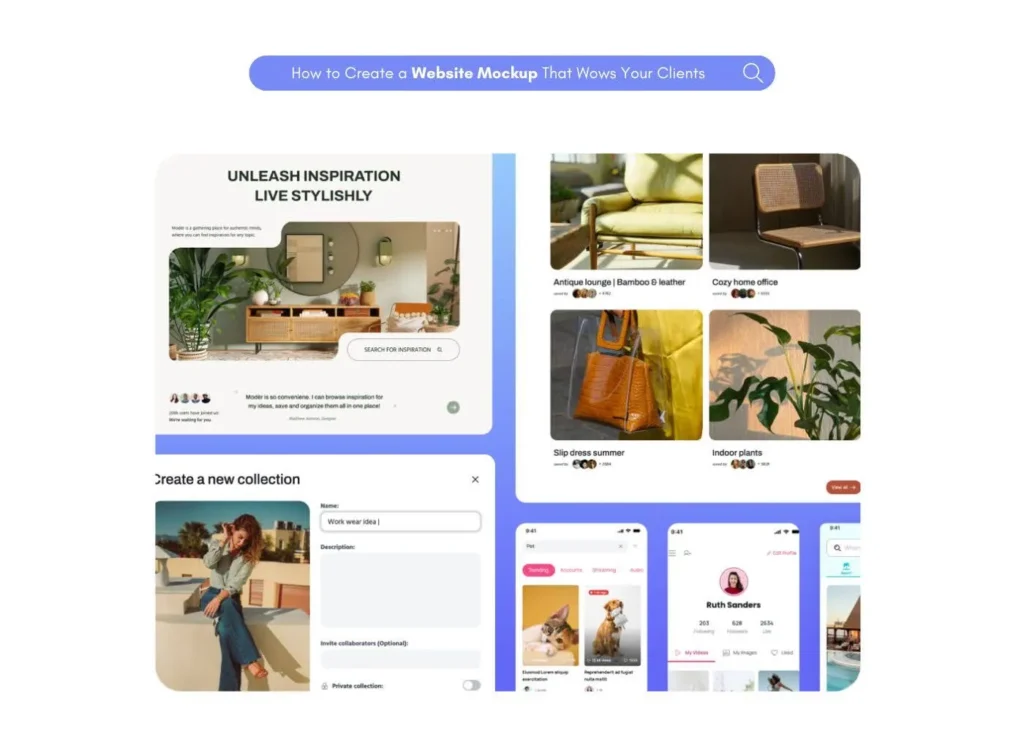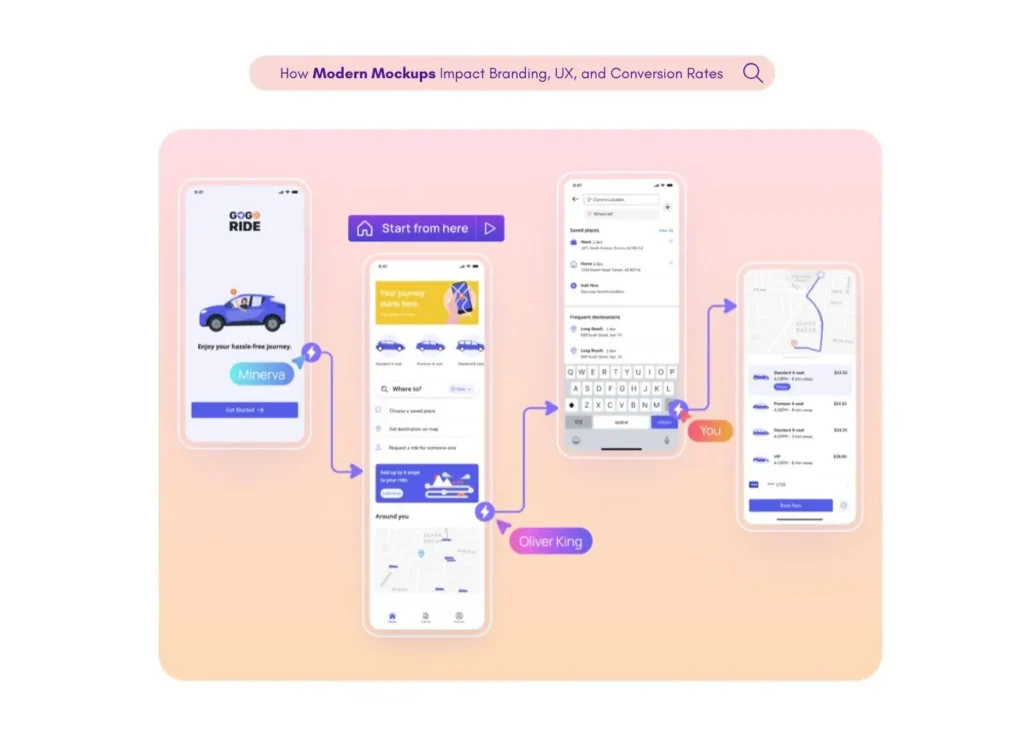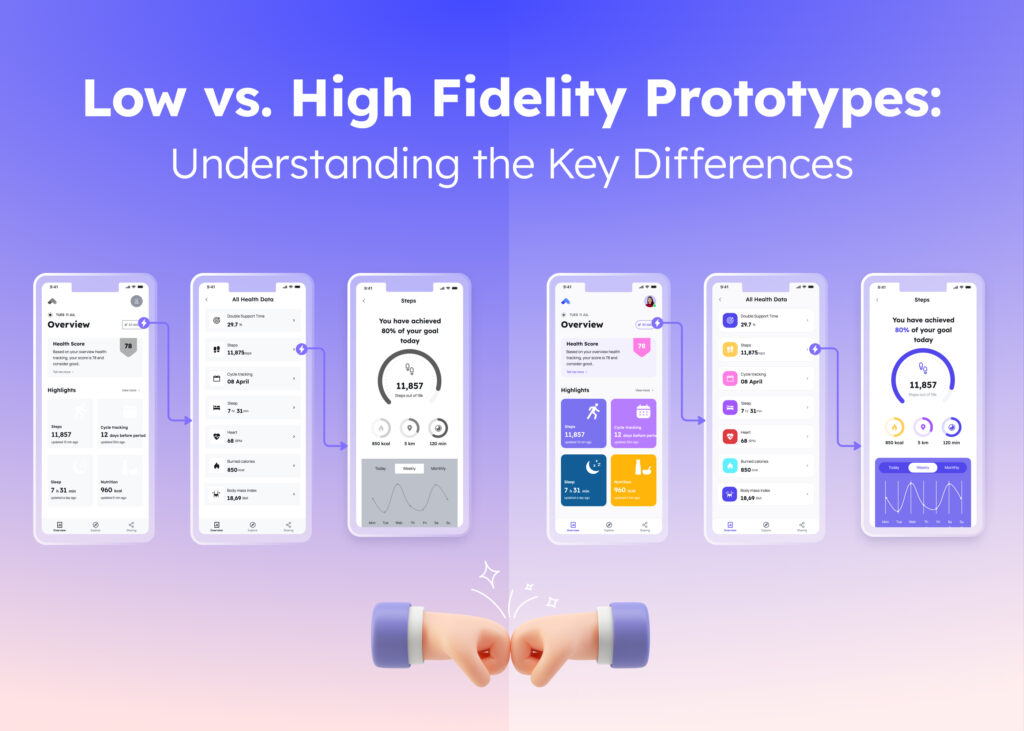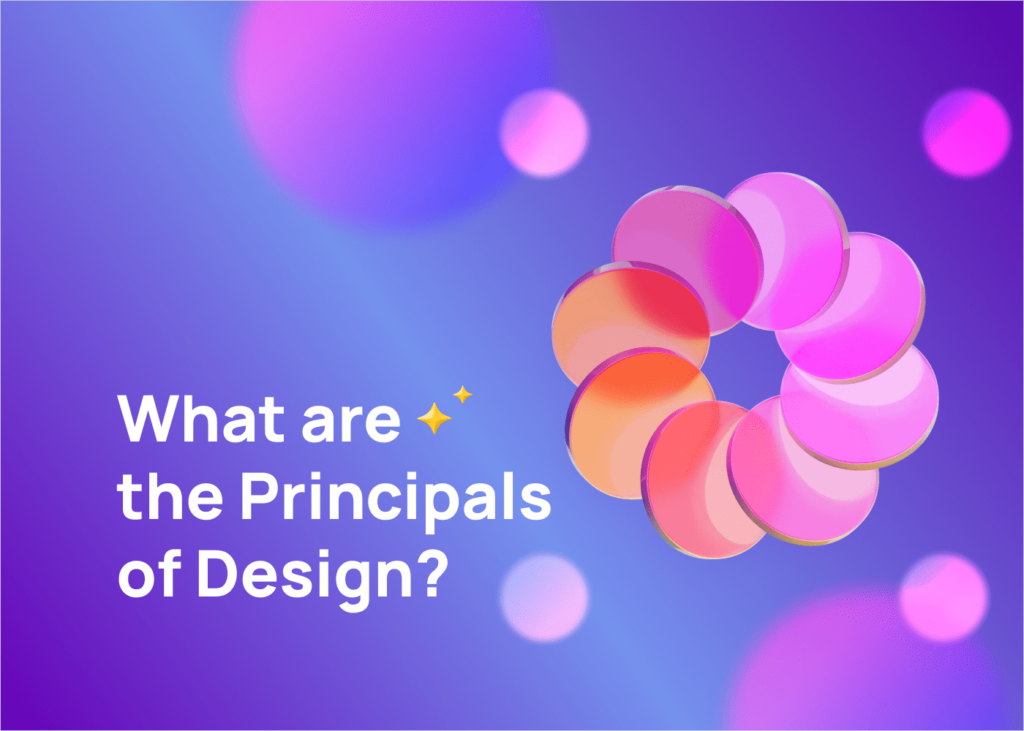
Great design is both an art and a science. A healthy dose of creativity is needed to reflect your brand and evoke a certain feeling in the visitor, but there are certain principles that need to be followed as well.
Whether you’re crafting a website, developing an app, or diving into any other digital project, these principles guide the way. Once you have them in the back of your head, you can let your creativity flow freely and create stunning designs your users are sure to love.
The 12 principles of design
There are 12 commonly accepted principles of design that humans tend to find appealing. Let’s delve deeper into each one and how they can be applied to websites and apps.
1. Balance
Balance, in the context of design, means ensuring that the visual weight of elements is evenly distributed across a layout. This equilibrium can be achieved through the strategic placement of elements, whether they’re colors, textures, or shapes.
There are two primary types of balance: symmetrical and asymmetrical.
In symmetrical balance, elements on both sides of the design are mirrored, creating a sense of harmony and order. Think of a butterfly’s wings, where each side mirrors the other. On the other hand, asymmetrical balance doesn’t rely on mirroring but rather on distributing elements in a way that the overall design feels stable, even if one side has heavier elements than the other.
In the realm of digital design, achieving balance is paramount. It ensures that no section or element overpowers another, allowing for a harmonious and user-friendly layout. A well-balanced design can guide the user’s eye and make navigation intuitive, enhancing the overall user experience.
2. Contrast
Contrast means creating a visual distinction that captures attention. This variance can be achieved in numerous ways, such as juxtaposing dark and light colors, playing with large and small sizes, or even contrasting bold and thin fonts.
When it comes to web and app design, contrast plays a pivotal role. It’s not just about aesthetics; it’s about functionality. A well-contrasted call-to-action button, for instance, stands out, prompting users to click. Similarly, contrasting text from its background ensures readability, making sure users can easily consume the content. By effectively leveraging contrast, designers can guide users’ attention to the most crucial parts of a design, ensuring that key messages are conveyed and actions are taken.
3. Emphasis
Every design, be it a poster, a website, or an app, has elements that demand attention. These could be headlines, logos, or call-to-action buttons. Emphasis, as a design principle, ensures that these pivotal elements don’t get lost in the crowd. It’s about making certain parts of a design “pop”, ensuring they capture the viewer’s attention.
Achieving emphasis can be an art. Designers often play with various tools to create emphasis: making an element larger, placing it in a prominent position, using a contrasting color, or even surrounding it with white space. The goal is to make that element the focal point, guiding the viewer’s eye to it.
In digital design, emphasis is a subtle way of navigating users through a digital journey, ensuring they engage with the most important parts of the content.
4. Proportion
Proportion in design is akin to the rhythm in music. It’s about ensuring that each element harmonizes with the rest in terms of visual weight and size. When elements are proportioned correctly, they feel “right” in relation to each other, creating a cohesive and balanced design. This principle ensures that no element overshadows another and that each is given its rightful space.
The size and weight of elements can directly influence the user’s experience. For instance, a disproportionately large image might push crucial information below the fold, making it less likely for users to see it. Conversely, a too-small font might hinder readability. By mastering proportion, designers ensure that websites and apps are not only aesthetically pleasing but also functional, enhancing user engagement and satisfaction.
5. Hierarchy
Hierarchy is the principle that organizes elements based on their significance, ensuring that the most crucial information captures attention first. Hierarchy is not just about size; it’s about placement, color, and even typography.
In digital platforms, where users often skim content, a well-defined hierarchy is indispensable. It ensures that the viewer’s eye is drawn to primary information first, like headlines or call-to-action buttons, before moving on to secondary or tertiary details. This structured presentation not only enhances the user’s experience but also ensures that the core message or action is effectively communicated.
6. Repetition
Repetition is the recurring use of elements, colors, shapes, or motifs. It’s a principle that creates a rhythm, much like a repeated chorus in a song.
By consistently using certain colors, logos, or design motifs, brands can create a distinct identity. This consistent repetition ensures that users or viewers instantly recognize and resonate with a brand or message. For instance, a repeated color scheme on a website can reinforce branding, making it memorable for users. Similarly, a recurring design motif can act as a visual cue, guiding users through different sections of a website or app.
7. Rhythm
Rhythm in design is akin to the beat in music—it’s the principle that introduces patterns or sequences, creating a flow that guides the viewer’s eye seamlessly from one section to another. Just as a consistent rhythm in a song can make it catchy, a rhythmic design can make a website or app more engaging. This organized movement can be achieved through repetition, alternating elements, or progressive patterns.
In digital spaces, rhythm ensures that content is digestible. It breaks monotony, making long stretches of information or images feel less overwhelming. By setting a consistent pace, rhythm ensures that users move through a digital platform in a guided and intuitive manner, enhancing their overall experience.
8. Space
Space, particularly negative or white space, is the canvas upon which all design elements rest. It’s not just about emptiness—it’s a powerful design tool that dictates how other elements interact. Proper utilization of space ensures designs are uncluttered, breathable, and aesthetically pleasing.
In the realm of web and app design, space is paramount. It can be used to highlight or emphasize certain elements, making them stand out. Moreover, adequate spacing improves readability, ensuring that text or interactive elements aren’t cramped together. This strategic use of space, especially in digital platforms, ensures that users can easily navigate and interact without feeling overwhelmed, leading to a more enjoyable and efficient user experience.
9. Unity
Unity in design is the invisible thread that ties every element together. It’s the principle that ensures every piece, whether it’s a color, shape, or font, feels harmoniously interconnected. A design exuding unity feels complete and well-thought-out, where every element complements the other.
In digital platforms, unity takes on a pivotal role. As users navigate through different sections of a website or app, a sense of unity ensures they always feel grounded. It provides a consistent user experience, ensuring that transitions feel smooth and that users aren’t jarred by sudden design changes. This cohesive experience, achieved through consistent color schemes, typography, or design motifs, ensures that users remain engaged and don’t feel lost or disoriented. Unity, in essence, is the glue that binds the digital experience together.
10. Movement
Movement in design is the subtle art of guiding the viewer’s eye, creating a dynamic flow that brings static elements to life. It’s not always about literal motion, like animations or transitions. Often, it’s the strategic placement of elements, lines, or even colors that suggest a direction or flow. This principle ensures that viewers are not just passive observers but are taken on a visual journey.
In the digital realm, movement is paramount. It keeps users engaged, ensuring that their interactions with a platform are not static or monotonous. Whether it’s the way icons animate on hover or how a page transitions, subtle hints of movement can elevate the user experience, making it more immersive and memorable.
11. Variety
While consistency is key in design, variety ensures that this consistency doesn’t border on monotony. It’s about introducing elements that surprise and delight the viewer, breaking the predictable pattern. This could be an unexpected color splash, a unique graphic, or even a playful font.
In web and app design, variety plays a crucial role in retaining user interest. It ensures that while there’s a consistent theme or feel, there are also elements that capture attention and spark curiosity. By strategically introducing variety, designers can create platforms that are not only functional but also vibrant and engaging, ensuring users always have something new to discover.
12. Alignment
Alignment is the silent force that brings order to designs. It’s the principle that dictates how elements line up in relation to each other, be it horizontally or vertically. Proper alignment ensures that there’s a visual connection between elements, creating a clean, organized look.
In the world of digital design, alignment is non-negotiable. Whether it’s aligning text to ensure readability, positioning images for maximum impact, or ensuring icons line up perfectly, alignment plays a pivotal role. It not only enhances the aesthetic appeal but also ensures that users can process information efficiently. A well-aligned design feels intuitive, guiding users effortlessly through content, ensuring they extract the maximum value without any visual distractions.
Use these principles of design to bring your visions to life with Visily
Keeping track of these design principles can be overwhelming, especially for those without a design background. That’s where Visily shines. As a platform tailored for those new to digital design, Visily offers an extensive library of templates, each meticulously crafted to uphold the essential principles of design.
For those grappling with the concept of balance, Visily’s templates are a lifesaver. The elements are distributed evenly, creating harmonious layouts without the guesswork. The platform’s Screenshot to Design AI allows users to effortlessly transform their visions into structured designs. This feature is particularly beneficial for those who might have a clear idea but lack the technical skills to bring it to life.
Contrast and emphasis, two pivotal design principles, are also seamlessly integrated into Visily’s vast template library. With intuitive color palettes and typography options, users can highlight key elements, ensuring they stand out and capture attention.
Furthermore, Visily’s emphasis on responsive design ensures that your creations look impeccable on any device. This focus embodies the principles of flexibility and responsiveness, ensuring your designs adapt and deliver, regardless of the screen size.
But what truly sets Visily apart is its user-friendly interface. Even if you’re a complete beginner, the platform guides you, ensuring that principles like hierarchy, rhythm, and space are effortlessly integrated into your designs. The drag-and-drop functionality, combined with real-time previews, means you can experiment, iterate, and perfect your design without diving deep into complex design software.
In essence, Visily democratizes the design process. It bridges the gap between understanding design principles and applying them, making the journey from concept to creation swift and straightforward. So, if you’re eager to bring the principles of design to life in your digital projects, look no further. Sign up for a free Visily account today and embark on a transformative design experience.




